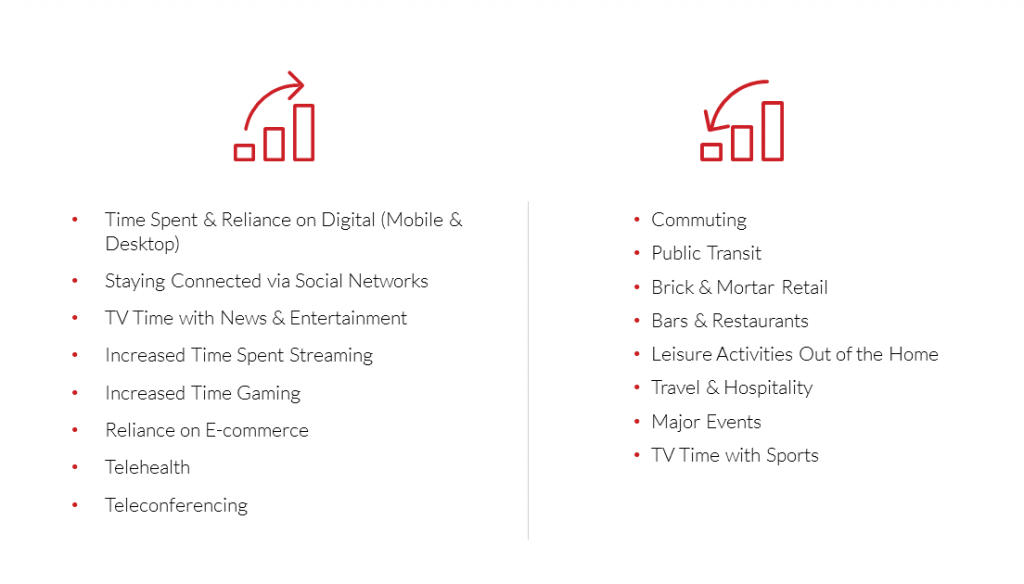We believe the impact of COVID-19 on global, regional, and local marketing and advertising stems from a truly human response to a completely unique zeitgeist. Marketers and customers alike face uncertainty surrounding health, social, and economic stability with no immediate end in sight. Marketers are torn between the need to support their brands while remaining keenly aware of the appropriate messaging and action needed during this unprecedented time. Behavioral shifts such as working remotely, spending more time indoors, researching real-time news, juggling kids at home, adapting to homeschooling, avoiding crowded areas, and focusing on health first have all had significant impacts on advertising and marketing efforts.
The unprecedented shift is creating the urgent need for brands and their partners to think outside the box and pivot quickly. Because Perficient’s DNA is fundamentally wired to look for positives we’ve found that these behavior shifts have created real opportunities to digitally connect with customers more than ever before. But doing so comes with the increased responsibility of being both mindfully and socially responsible when it comes to messaging and digital marketing strategies.
Significant Shifts in Customer Habits
Widespread concern and recent stay-at-home restrictions have led to multiple changes in the day-to-day habits of customers worldwide. A recent study by the Pew Research Center found that nearly nine-in-ten U.S. adults say their life has changed at least a little as a result of the COVID-19 outbreak, including 44% who say their life has changed in a major way. Many activities that previously accounted for significant portions of an individual’s day have been restricted in this season of self-isolation and social distancing, causing major shifts in time spent on other matters.

When thinking about how best to respond to COVID-19, marketers should focus on returning to the basics. They need to analyze where and how their customers are now spending their time. A solid understanding of these shifts will uncover opportunities for marketers to continue to engage their customers responsibly and create targeted long-term impacts.
Real Impacts on Marketing Efforts
Changing customer habits naturally leads to variations in media consumption, which in turn causes marketers and advertisers to revisit their existing marketing efforts. A pandemic undoubtedly propels this notion into high gear as they try to find the best balance between guarding their brand while maintaining a successful business.
According to the Interactive Advertising Bureau, 63% of marketers plan to change their messaging strategy as a result of COVID-19, while another 17% have not yet decided. Projections from eMarketer show that global media spending will take a hit as a result of COVID-19. However, it’s too early to predict the full extent in countries where the effects are still evolving.
With the longevity of this crisis still unknown, it will be essential to continue evaluating the impacts on the marketing and advertising ecosystem as the situation develops. Below are a few current implications to consider:
- Overall
- Marketers are focusing on making every touchpoint matter by leaning into marketing automation and UX. Some are accelerating activities in those areas.
- Marketers are scaling up spend in channels that align with customer behavior shifts and cutting costs where they are no longer relevant or appropriate.
- E-commerce advertising is forecasted to grow by 17.7%, and social media spending is expected to rise by 22.2% (according to research from The Drum) — while people seek answers on social media and their home goods needs via e-commerce channels.
- Many brands are pivoting from “come visit/shop/purchase/dine/join” messaging to a more relevant and timely human and health-focused message, some focused primarily on an evergreen branding strategy.
- Media Channels
- Traditional TV ad spend is being impacted due to consumption losses with the suspension of most live sporting events.
- Out-of-home advertising spend is already declining due to social distancing and self-isolation, while people are spending increased time online.
- People are increasing time spent with social, advanced TV, and gaming for indoor entertainment.
- Marketers are leaning on digital alternatives to offset event cancellations (video conferencing, virtual events), which magnifies the need for 5G technology and improved mobile experiences.
- Marketers are focusing more on high traffic channels like Amazon DSP, paid search, and social to follow news and shopping trends.
- We will continue to see an uptick in contextual targeting strategies, being cognizant of where ads are running, and against keywords that may have a negative impact.
- Measurement
- Campaign measurement and KPI expectations are likely to adapt to the market – shifting away from CPA or ROAS and looking at longer lifetime value or profitability-based metrics.
Digital Marketing Recommendations
So, what should you do next? Here are our recommendations for what to do today to mitigate risk and create opportunities.
Check Your Numbers: Make sure you’re evaluating all angles of your business health, including revenue trends, retail foot traffic, and website traffic, to understand how COVID-19 is impacting your business. If you currently don’t have visibility into how these metrics impact your business, now is the time to catalog your needs so you can solve for the gaps later.
Assess Your Brand’s Value: In today’s world, people are turning to brands to meet their current needs state. Understanding that needs state and where your brand fits might mean temporarily shifting strategies. Should you consider steep discounts during a very defined timeline to generate revenue compared to limited to no sales at all? If brands can create opportunities for customers to try new things, such as a short-term loyalty discount, they may gain full-price customers going forward.
Do you see shifts in purchasing behavior across your revenue channels? For example, if you’re noticing a trend from retail to online purchases, quickly revising your messaging strategies to focus on online calls to action may translate to higher short-term sales. Strive to smartly align that messaging strategy across organic and paid channels to communicate outwards while staying true to your brand’s core values.
Remember to keep an eye on your customers’ spending trends, competitors’ messaging, and media presence. Identify ways to mitigate shifts in brand loyalty and look for opportunities to gain market share. Each market/state is operating in a different reality and timeline. Make sure you’re evaluating market-level performance and optimizing your marketing strategy within each market.
Evaluate and Test Your Messaging: Examine messaging that is receiving positive traction within your website, organic media, and paid media. Shift your messaging to align with where you’re seeing positive results. Also, avoid promoting in-need products via Search or Shopping campaigns if items are not in stock. One way to explore opportunities to build your brand is to test different types of messaging. Use this time to delve into A/B testing and conversion optimization strategies that you can use to accelerate growth when things return to normal.
Maximize Changes in Media Consumption Trends: It’s no surprise media consumption is changing as more people alter their daily routines. Shifting your media channel mix can align with opportunities in market and performance within your campaigns. Is it still profitable to acquire new customers? How are you focusing on retaining your current customers? Exploring strategies and platforms to message specifically to your existing client base is equally as important as attaining your next customer. Determine the lines of profitability within your paid media. If you’re netting loss, consider changing messaging strategy unless your focus is maintaining brand equity rather than driving revenue creation.
Remember That We’re All In This Together: Great brands inspire people. That emotional connection powers brand loyalty and longer customer lifetime value. Explore opportunities to build that brand connection within paid and organic channels. Also, be transparent with how you respond to your employees and be sure that the message is visible and easily accessible for your customers to find.
Look Ahead: We’ll get through this. Looking back at past market downturns and rebounds gives us a glimpse of how customers can and will spend after COVID-19 crisis has ended. This knowledge can empower your teams to create thorough marketing strategies that will accelerate growth when we rebound together globally.


Insightful and detailed, this blog is a very concise representation of how Digital Marketing has been impacted from the pandemic!